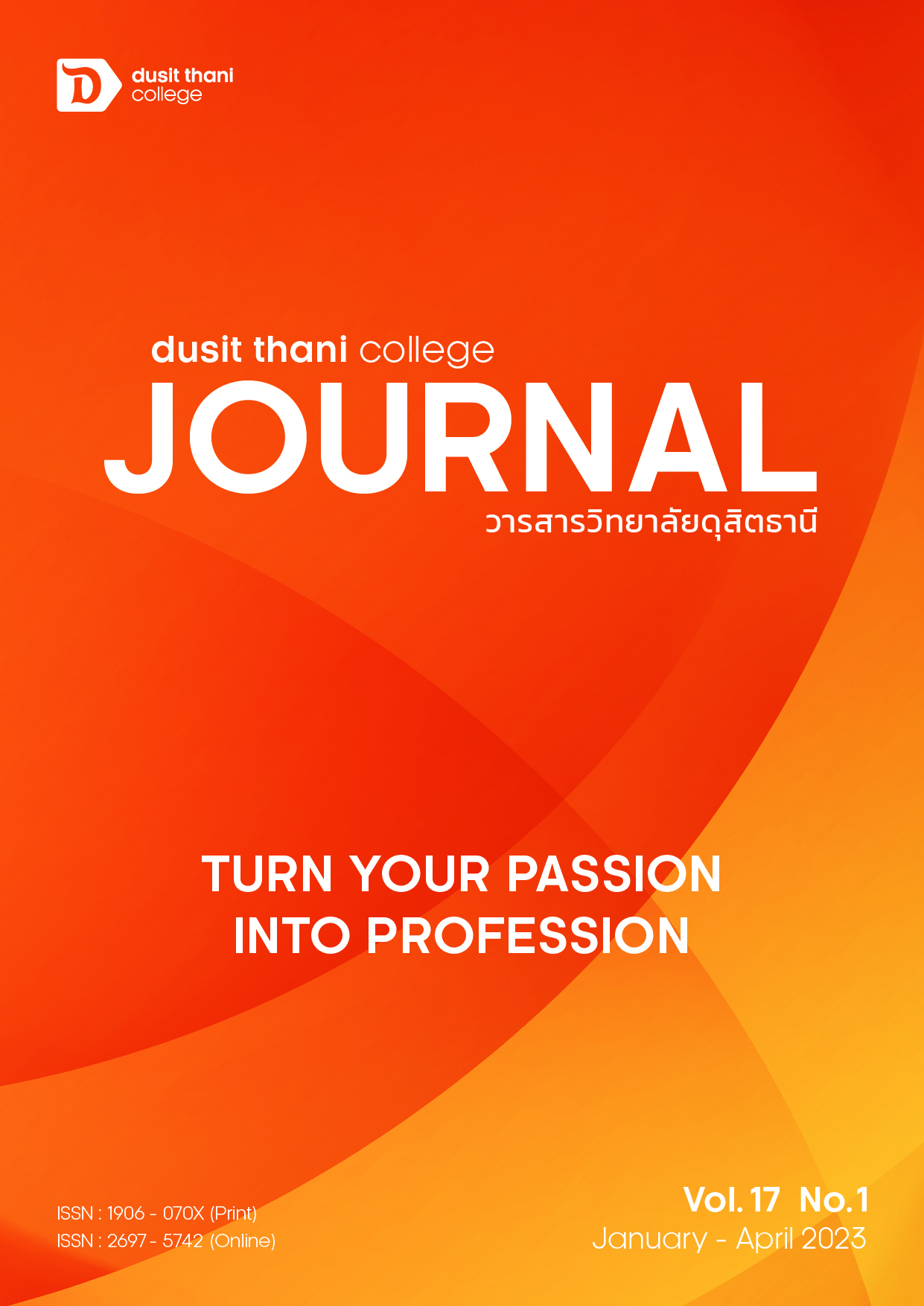การพัฒนาผลิตภัณฑ์แป้งผสมกึ่งสำเร็จรูปสำหรับขนมมันสำปะหลังนึ่ง
Main Article Content
บทคัดย่อ
งานวิจัยนี้มีวัตถุประสงค์เพื่อพัฒนาผลิตภัณฑ์แป้งผสมกึ่งสำเร็จรูปสำหรับขนมมันสำปะหลังนึ่ง ที่เป็นที่ยอมรับของผู้บริโภค โดยทำการศึกษาอัตราส่วนปริมาณน้ำที่เหมาะสมในแป้งผสมกึ่งสำเร็จรูปสำหรับทำขนมมันสำปะหลังนึ่ง และทำการวิเคราะห์คุณภาพทางกายภาพ เคมี และจุลินทรีย์ รวมทั้งทำการศึกษาการยอมรับของผู้บริโภค การทดลองครั้งนี้ทำการศึกษาอัตราส่วนปริมาณน้ำที่เติมในผลิตภัณฑ์แป้งผสมกึ่งสำเร็จรูป 3 ระดับ คือ ร้อยละ 40 45 และ 50 พบว่า สูตรแป้งผสมกึ่งสำเร็จรูปสำหรับขนมมันสำปะหลังนึ่งที่ใช้ปริมาณน้ำร้อยละ 50 ในการคืนตัว ให้คะแนนการยอมรับด้านลักษณะปรากฏ สี รสชาติ กลิ่นรส เนื้อสัมผัส และความชอบโดยรวมสูงสุด เมื่อเปรียบเทียบกับการใช้ปริมาณน้ำร้อยละ 40 และ 45 ตามลำดับ โดยมีคะแนนเฉลี่ยด้านรสชาติ กลิ่นรส เนื้อสัมผัส และความชอบโดยรวมรองลงมาจากขนมมันสำปะหลังนึ่งสูตรมาตรฐานซึ่งมีค่าเท่ากับ 7.10±1.20 7.06±1.24 7.06±1.33 และ 7.12±1.14 ตามลำดับ ผลการศึกษาคุณภาพของขนมมันสำปะหลังนึ่งที่การใช้ปริมาณน้ำร้อยละ 50 ในการคืนตัว คุณภาพทางด้านเคมี พบว่า มีปริมาณความชื้น โปรตีน ไขมัน เยื่อใย เถ้า และคาร์โบไฮเดรต มีค่าเท่ากับ 50.05±0.16 1.67±0.11 7.39±0.08 0.69±0.08 0.91±0.06 และ 39.30±0.34 ตามลำดับ ส่วนคุณภาพทางด้านจุลินทรีย์ ได้แก่ ปริมาณแบคทีเรียทั้งหมด ยีสต์ และเชื้อรา มีค่าอยู่ในเกณฑ์มาตรฐานผลิตภัณฑ์ชุมชน เรื่อง ขนมไทย (มผช.1/2552)
Article Details

อนุญาตภายใต้เงื่อนไข Creative Commons Attribution-NonCommercial-NoDerivatives 4.0 International License.
นโยบายการพิจารณากลั่นกรองบทความ
- บทความวิจัยและบทความวิชาการทุกเรื่องที่จะได้รับการตีพิมพ์ต้องผ่านการพิจารณากลั่นกรองโดยผู้ทรงคุณวุฒิ (Peer Review) ในสาขาที่เกี่ยวข้อง จำนวน 3 ท่าน/บทความ
- บทความ ข้อความ ภาพประกอบและตารางประกอบที่ลงตีพิมพ์ในวารสารเป็นความคิดเห็นส่วนตัวของผู้เขียน กองบรรณาธิการไม่จำเป็นต้องเห็นด้วยเสมอไป และไม่มีส่วนรับผิดชอบใด ๆ ถือเป็นความรับผิดชอบของผู้เขียนแต่เพียงผู้เดียว
- บทความที่จะได้รับการตีพิมพ์จะต้องไม่เคยตีพิมพ์ เผยแพร่ที่ใดมาก่อน และไม่อยู่ระหว่างการพิจารณาของวารสารฉบับอื่น หากตรวจสอบพบว่ามีการตีพิมพ์ซ้ำซ้อน ถือเป็นความรับผิดชอบของผู้เขียนแต่เพียงผู้เดียว
- บทความใดที่ผู้อ่านเห็นว่าได้มีการลอกเลียนหรือแอบอ้างโดยปราศจากการอ้างอิง หรือทำให้เข้าใจผิดว่าเป็นผลงานของผู้เขียน กรุณาแจ้งให้กองบรรณาธิการวารสารทราบจะเป็นพระคุณยิ่ง
เอกสารอ้างอิง
Abioye, V. F., Adeyemi, B. A., Akinwande, P., Kulakow, P. and Maziya-Dixon, B. (2017). Effect of steam cooking and storage time on the formation of resistant starch and functional properties of cassava starch. Cogent Food & Agriculture. 3(1): 1-11.
Announcement of the Thai Industrial Standards Institute No. 1531. (2009). Subject: Thai dessert community product standard (MorChor. 1/2009). November 16, 2009.
AOAC. (2016). Official methods of analysis of AOAC international (18th ed.). New York: Author. Thai Dessert in Thailand. Journal of Cultural Approach, 15(27), 39-50.
Chaiwat Saocharoensuk. (2010). Business/Industry Trends 2022-2024 : cassava. Retrieved from ้https://www.krungsri.com/th/research/industry/industry-outlook/agriculture/cassava/IO/io-cassava-21.
Department of International Trade Promotion, Ministry of Commerce, THAILAND. (2021). Cassava products. Retrieved from https://ditp.go.th/ditp_web61/article_sub_view.php?filename=contents_attach/750855/750855.pdf&title=750855&cate=1469&d=0.
Department of Science Service, Ministry of Science and Technology. (2018). Tapioca and products. Ready-to-Use information Electronic Information Group Library and Science and Technology Information Center, May, 2017.
Jadeniphat Bunyasawat and Charkkrawut Bhoosem. (2019). The Development of Filling Dessert from Cassava in Bakery Products. Research report 2019. Faculty of Home Economics Technology. Rajamangala University of Technology Phra Nakhon.
Jinnajar Hansethasuk. (2009). Properties and Benefits of Tuber and Cassava Starch. Academic papers. Department of Agriculture, Ministry of Agriculture.
Kasidit Suveewaranon. (2017). Guldelines for Channel of Distribution and Marketing Development of Online Thai Dessert Store : Study of Mea-A-Roon Thai Dessert Store. (Master of Management independent study report), Mahidol University.
Patchara Buphi. (2007). Use of high protein fermented cassava in broiler feed. (Master's thesis Animal Production), Maejo University.
Sunanta Thongtha and Thanawit Kulrattanarak (2013). Production of citrate resistant starches to enzymes. research report Received a research grant from Suranaree University of Technology, fiscal year 2012-2013.
Suttida, S., Nunyong, F., Patthama, H., Jiraporn, W., and Tidarat, S. (2021). Effects of House Cricket (Acheta domesticus) Powder on the Texture, Sensory Properties and Nutritional Values of Cassava Flour-brownies. Phetchaburi Rajabhat University Science Journal, 18(1). 42-51.
Villiere, A., Roy, S. L., Fillonneau, C., Guillet, F., Falquerho, H., Boussely, S. and Prost. C. (2015). Evaluation of aroma profile differences between sue, sauteed, and pan-fried onions using an innovative olfactometric approach. Flavour. 24(4): 1-19.
Villager technology. (2022). Tips on how to grow cassava maximum productivity and reduce the cost of making the cassava version by 30%. Retrieved from https://www.technologychaoban.com/bullet-news-today/article_156741
Wilai Rangsatthong. (2000). Food processing technology. King Mongkut's Institute of Technology North Bangkok, Text and Journal Publication, Bangkok.
Obcheuy Wongtong. (2019). Multi-dimensional Thai desserts. Kasetsart University Press.
Office of Agricultural Economics. (2021). Agricultural Economics Data. Retrieved from https://www.oae.go.th/view/1.


